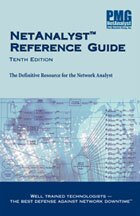A Network Reference Guide You'll Actually Use
Warren Wyrostek discovers the ultimate little blue book for networking professionals.
by Warren E Wyrostek
11/30/2000 --
 |
 |
 |


| Title |
|
 |
|
"NetAnalyst Reference Guide, 10th Edition" |
 |
| Authors |
|
|
|
NetAnalyst |
 |
| Publisher |
|
|
|
Pine Mountain Group |
 |
| Publication Date |
|
|
|
2000 |
 |
| ISBN |
|
|
|
1-58392-002-1 |
 |
| Price |
|
|
|
$65 (U.S.) |
 |
| Pros |
|
|
|
Short, complete, compilation of data needed when analyzing LANs and WANs. |
 |
| Cons |
|
|
|
Fonts were too small for several of the tables; no tables listing RFCs. |
 |
| Verdict |
|
|
|
Those doing network analysis will treasure this compilation of vital data. |
|
|
|
|
|
|
|
|
|
|
|
|
 |
Most books classified as "reference books" or "reference guides" are doomed to collect dust and monopolize valuable space on overcrowded bookshelves. Though initially coveted, most reference texts are never given a second thought after purchase. People in networking, especially those who perform network analysis, will take a different view of the "NetAnalyst Reference Guide, 10th Edition" published by Pine Mountain Group Inc. Just like a little black book, this little blue book presents difficult-to-remember information in a single, compact resource. Short and concise, it's an invaluable resource for all networking professionals.
When I first looked at this "definitive resource for the network analyst" I was taken by how brief it was. I figured that this text did not have a lot to offer. Boy, was I wrong. I cannot tell you how many times clients and students of mine have posed a problem to me that caused me to search multiple texts, CDs or Web sites in order to find a solution. For example, a specific SAP address, port number, vendor OUI or multicast address shows up in a packet capture. What does this number mean? What happens if I filter this SAP? Where is a reference that will give me a key to what I am looking at? This book provides answers.
In a brief 197 pages, the Guide presents a vast compilation of network data that will assist anyone designing, administering, managing or troubleshooting LANs and WANs. The text is made up of data presented in four major sections: packet encapsulation, protocols, network documentation and, lastly, the section I found most valuable, reference and information tables. This is not a book you sit down and read cover to cover. You can scan the material in each section briefly, mentally catalog it, and then keep the text readily available. The concluding 46-page Appendix has eight additional reference tables, which include SAP addresses and Ethertypes. The concise dissection of Ethernet and Token Ring Frames stood out to me, as well as the packet structure discussion of IP, IPX, NetBIOS and AppleTALK protocols. Detailed lists of vendor OUIs and multicast addresses are the two major areas covered in the Reference and Information Tables section. Anyone wanting to find a NIC or router port that has gone awry will flock to these tables.
The book does have a couple of shortfalls. The first is that there is no listing of RFCs. With such heavy coverage of IP-related technologies, a table of RFCs would benefit network troubleshooters who need to do further research. The second shortfall is that the size of the text in some of the tables is too small. Those who wear glasses or contacts will have trouble with some of the more detailed tables.
Overall, this book is an invaluable resource to network troubleshooters, administrators, technicians and students struggling to get their MCSE, CNE, CCIe, etc. Anyone who does network analysis will treasure the "NetAnalyst Reference Guide, 10th Edition." 
Have you read this book? Let us know what you think! Rate it below or enter our Forums.
Warren E. Wyrostek, M.Ed., MCNI, MCSE+Internet, MCT, CIW CI is devoted to technology education as reflected by his list of certifications including MCNI, MCNE, MCIWA, A+, Network +, i-Net+ and CCNP. Warren’s main joy comes as a contract trainer in Prosoft, Microsoft, Novell and CompTIA technologies. At heart, he is a teacher who loves what education offers. You can reach Warren at
More articles by Warren E Wyrostek:
|

 Book Review Article
Book Review Article
